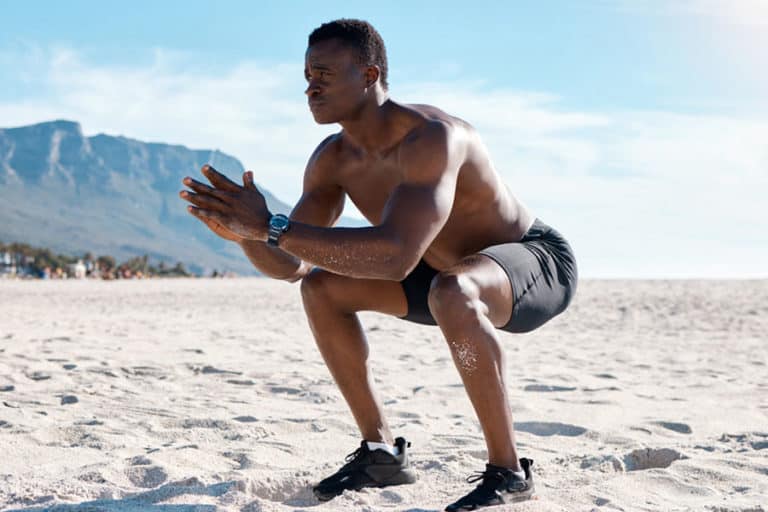Landmine Squat – How To Do, Benefits and Safety Measures

How to do | Muscles worked | Who Should/Should Not | Add to routine | Safety Tips | Benefits | Variations
The landmine squat is a front/anterior-loaded, advanced squats. It is performed by squatting while lifting an angled barbell attached to a landmine device on the floor.
The significance of this squat is that it works the lower body by targeting the quads more than a traditional squat. Moreover, it places less stress on the lower back while working on increasing full-body strength.
How to do a Landmine squat?
Landmine squats (alternative names: landmine squat press or landmine squat to press) are performed using a barbell.
Since weights are involved in this exercise, it is extremely important to practice the exercise with the correct form to avoid injury. Here is a step-by-step guide on performing landmine squats with proper form:
Step 1: Equipment arrangement
- Pick a barbell and place it in a landmine machine.
- Load the free end of the barbell with weight plates (load it as per your desired intensity/capacity).
Step 2: Establish the starting position
- Stand with your feet shoulder-width apart while facing the barbell.
- Crouch down to pick the barbell.
- Grasp the free end of the barbell by interlocking your hands.
- Now lift the barbell off the floor and hold it at your chest level.
Step 3: Execution of the landmine squat
- Keep your torso upright and core engaged, and begin to squat down with your hips back while holding the barbell at chest height.
- Squat as deep as possible (at least until your thighs are parallel to the floor, if not deeper).
- Ensure your knees are in line with your toes while you squat.
- Hold the pose at the bottom of the squat.
Step 4: The drive up
- After holding the pose for a moment, push up through your heels while extending your knees, and bringing the hips back to the initial position.
- Ensure you maintain the barbell at chest level throughout.
The Landmine Squat: Muscles Worked
The landmine squat is a weighted squat. Moreover, it is a squat variation, and hence it is also a compound exercise. Compound exercises [1]Australian Fitness Academy: WHAT ARE COMPOUND EXERCISES? work multiple muscles and joints simultaneously. Given below is a list of muscles the landmine squats work:
Primary muscles worked
| Quadriceps | rectus femoris, vastus lateralis, vastus intermedius, and vastus medialis |
| Hamstrings | semitendinosus, semimembranosus, and biceps femoris |
| Gluteal muscles | gluteus maximus, gluteus medius, and gluteus minimus |
| Calf muscle | gastrocnemius and soleus |
Secondary muscles worked
| Inner thigh muscles | gracilis, adductor brevis, adductor longus and adductor magnus |
| Hip flexors | iliacus, psoas, pectineus, and sartorius |
| Scapular Stabilizers | serratus anterior |
| Abdominal muscles | external obliques, internal obliques, rectus abdominis, transversus abdominis |
| Upper back muscles | trapezius muscles |
| Shoulder muscles | deltoids |
Who should and should not do the landmine squat?
Landmine squats are highly recommended for a certain set of people and are discouraged for some others. To understand whether landmine squats are meant for you or not, go through the following sections:
Who should do the landmine squats?
- Individuals interested in building muscle mass in their legs (quads) must include the landmine squat in their routine. The landmine squat is a front-loaded strength training exercise that targets the quad muscles and strengthens them over time.
- Landmine squats are weighted squats that provide resistance while performing the exercise. Strength training [2]Mayo Clinic: Strength training: Get stronger, leaner, healthier exercises like these improve one’s body composition by reducing body fat. This makes the landmine squat a great exercise for those interested in toning and getting in shape.
- Sports athletes must include landmine squats in their routine. Squats are functional exercises [3]American Council on Exercise: What is functional strength training? that allow you to perform other activities with better mobility. The landmine squat is a variation of traditional squats. As such, it is bound to help sportspeople to improve their athletic performance.
- People performing advanced exercises such as Crossfit and other HIIT exercises can also benefit from practicing landmine squats.
- The landmine squat works as an accessory movement, i.e., it allows you to build muscular endurance to perform the primary lifts like the front squats and back squats with more ease. Thus, it can be a useful exercise for individuals pursuing activities like Olympic weightlifting.
Who should not do the Landmine squats?
- Landmine squats are generally considered safe. However, if you have had prior injuries, especially in the back, hips, and knees, or pre-existing medical conditions, perform landmine squats only under the care of a certified fitness instructor.
- Beginners should progress steadily and not attempt to perform an advanced squat like the landmine squat without proper guidance.
Add to your routine
It is essential to understand how to incorporate landmine squats into your routine. Given below are the number of sets and reps you should follow. The circuit provided here can work as a systematic workout plan.
- Beginner level: 2-3 sets of 6-10 reps
- Intermediate/advance level: 3-4 sets of 8-12 reps
Note: Modify the weights and the number of sets and reps as per your individual capacity.
In a circuit
If you are a beginner, here is a circuit for you to follow:
| Exercise | Reps/time |
| Mountain climbers | 5-7 mins |
| Bicep curls | 10-12 reps on each side |
| Shoulder press | 10-12 reps |
| Landmine squats | 6-10 reps |
| Bulgarian split squats | 12-15 reps on each side |
If you are at an intermediate/advanced stage, follow the table below:
| Exercise | Reps/time |
| Jump squats | 12-15 reps |
| Goblet squats | 10-12 reps |
| Landmine squats | 10-15 reps |
| Bench press | 6-10 reps |
| Front squats | 6-10 reps |
Safety measures to follow
Always perform the exercise adhering to the safety guidelines in order to avoid any injuries.
Avoid ego lifting
It is important to listen to your body and lift only as much weight as you can handle. Increase the weight gradually over time. Ego lifting may cause injury to yourself and can lead to mishaps that are dangerous for those around you. Stop immediately if you feel any strain or pain, and consult a doctor.
Use the proper squat form
It is imperative to use the proper squat form to avoid any injuries. You should:
- Keep your back straight to avoid lower back pain.
- Keep your knees in line with your toes, and do not let your knees cave inwards.
- Keep your heels flat on the floor, and do not raise yourself onto your toes as it may cause strain to your knees and shin bones.
- Keep your core muscles engaged throughout the move as they help you stabilize through the range of motion. If you fail to engage these muscles, you will not reap the full benefits of the exercise.
Use a spotter
It is recommended to use the services of a spotter while performing the exercise. As landmine squats are an advanced move, it requires you to perform them with the correct squat form. Thus using a spotter to guide you and assist you through the move will prevent you from injury.
Rest
It is advised to get enough rest between workouts. 24-48 hours of rest is enough for muscles to recover. This rest and recovery process will help the muscles grow.
Landmine squat benefits
Landmine squats have unique benefits. Here are some of the major benefits of this squat form:
- The landmine squats are anteriorly loaded like front squats. Anterior-loaded squats tend to have a lesser compressive force on the knee joints. Thus compared to other squats like back squats, they are knee-friendly and can be advantageous to people with minor knee problems[4]PubMed: A biomechanical comparison of back and front squats in healthy trained individuals.
- The landmine squat works the entire posterior chain and helps build lower body strength.
- Landmine squats have a low impact on all your joints. As the barbell is fixed to the ground, it moves in a fixed range motion. Unlike other squat exercises with weights, this does not pressurize your joints as you lift the load.
- It helps you correct your squat form and improve your technique. The landmine squat forces you to keep your torso upright. If you lean forward, it may cause the barbell to dig into your chest and cause injury.
- Front squats are often a popular choice for taller lifters, but front squats can be difficult to master. Landmine squats are a much easier alternative if being tall is getting in the way of your strength training.
Landmine squat variations to try
Landmine squats can be easily customized to adapt to any fitness level. Here are some landmine squat variations for you to try:
1. Landmine split squat
This variation of the landmine squat follows the same performance technique. However, to perform the landmine split squat, you need to place your legs in a lunge position instead of a squat position. This makes it a unilateral move that helps correct muscle imbalances [5]American Council on Exercise: The Benefits of Unilateral Training by isolating the leg muscles and working on them.
2. Landmine box/bench squats
To make the exercise easier, the landmine squat can be performed with a bench/box. For this variation, you would need to place a bench/box behind you. While performing the landmine box squat, your glutes must rest on the edge of the bench/box as you squat down. This will provide support as you squat and increase your confidence in performing squats.
3. Landmine hack squat
The landmine hack squat is a variation that requires you to stand with the barbell placed behind you. They are a much safer alternative than the hack squat exercise. The weight is loaded on your posterior chain. This ensures the shifting of weight onto your heels, leading to better lower-body muscle engagement.
Conclusion
Landmine squats can be beneficial for a wide range of people, provided they are performed with proper form and technique. These squats can be an excellent alternative for people who find front squats difficult. Finally, the exercise is easily adaptable to any fitness level, as there are variations that can be performed to make the exercise easier or more challenging.
References
| ↑1 | Australian Fitness Academy: WHAT ARE COMPOUND EXERCISES? |
|---|---|
| ↑2 | Mayo Clinic: Strength training: Get stronger, leaner, healthier |
| ↑3 | American Council on Exercise: What is functional strength training? |
| ↑4 | PubMed: A biomechanical comparison of back and front squats in healthy trained individuals |
| ↑5 | American Council on Exercise: The Benefits of Unilateral Training |







